child restraint TOYOTA MATRIX 2010 E140 / 2.G Owners Manual
[x] Cancel search | Manufacturer: TOYOTA, Model Year: 2010, Model line: MATRIX, Model: TOYOTA MATRIX 2010 E140 / 2.GPages: 448, PDF Size: 9.74 MB
Page 2 of 448

TABLE OF CONTENTSIndex
2
1-1. Key informationKeys ..................................... 24
1-2. Opening, closing
and
locking the
doors
Wireless remote control ....... 26
Doors.................................... 29
Back door ............................. 33
1-3.
Adjustable components
(seats, mirrors,
steering wheel)
Front seats
........................... 37
Rear seats ............................ 41
Head restraints ..................... 43
Seat belts ............................. 45
Steering wheel ..................... 51
Anti-glare inside rear view mirror .................................. 52
Outside rear view mirrors ..... 54
1-4. Opening a
nd closing the
windo
ws
Power windows .................... 56
Moon roof ............................. 58
1-5. Refueling Opening the fuel tank cap .... 61
1-6. Theft deterrent system Engine immobilizer system ................................ 65
Theft prevention labels (for U.S.A.) ......................... 67 1-7. Safety information
Correct driving posture ......... 68
SRS airbags ......................... 70
Front passenger occupant classification system ........... 82
Child restraint systems ......... 87
Installing child restraints ....... 91
2-1. Driving procedures Driving the vehicle .............. 102
Engine (ignition) switch....... 112
Automatic transmission ...... 116
Manual transmission........... 121
Turn signal lever ................. 123
Parking brake ..................... 124
Horn .................................... 125
2-2. Instrument cluster Gauges and meters ............ 126
Indicators and warning lights ................................. 129
2-3. Operating the li
ghts and
wipers
Headlight switch
................. 132
Fog light switch ................... 135
Windshield wipers and washer .............................. 136
Rear window wiper and washer .............................. 138
2-4. Using other driving systems Cruise control ..................... 139
Driving assist systems ........ 142
1Before driving
2When driving
Page 23 of 448
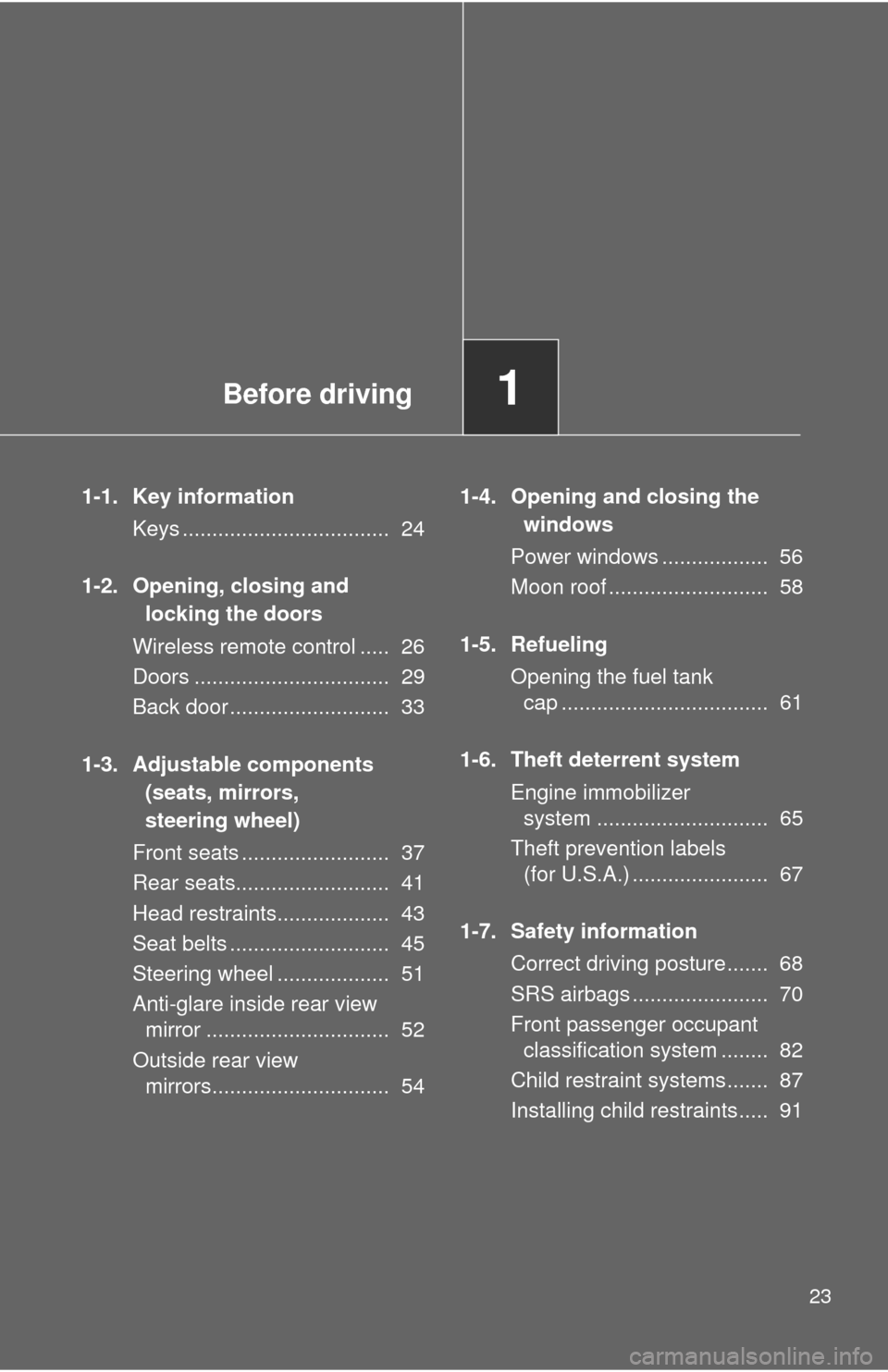
Before driving1
23
1-1. Key information
Keys ................................... 24
1-2. Opening, closing and
locking the doors
Wireless remote control ..... 26
Doors ................................. 29
Back door ........................... 33
1-3. Adjustable components
(seats, mirrors,
steering wheel)
Front seats ......................... 37
Rear seats.......................... 41
Head restraints................... 43
Seat belts ........................... 45
Steering wheel ................... 51
Anti-glare inside rear view
mirror ............................... 52
Outside rear view
mirrors.............................. 541-4. Opening and closing the
windows
Power windows .................. 56
Moon roof ........................... 58
1-5. Refueling
Opening the fuel tank
cap ................................... 61
1-6. Theft deterrent system
Engine immobilizer
system ............................. 65
Theft prevention labels
(for U.S.A.) ....................... 67
1-7. Safety information
Correct driving posture....... 68
SRS airbags ....................... 70
Front passenger occupant
classification system ........ 82
Child restraint systems....... 87
Installing child restraints..... 91
Page 46 of 448
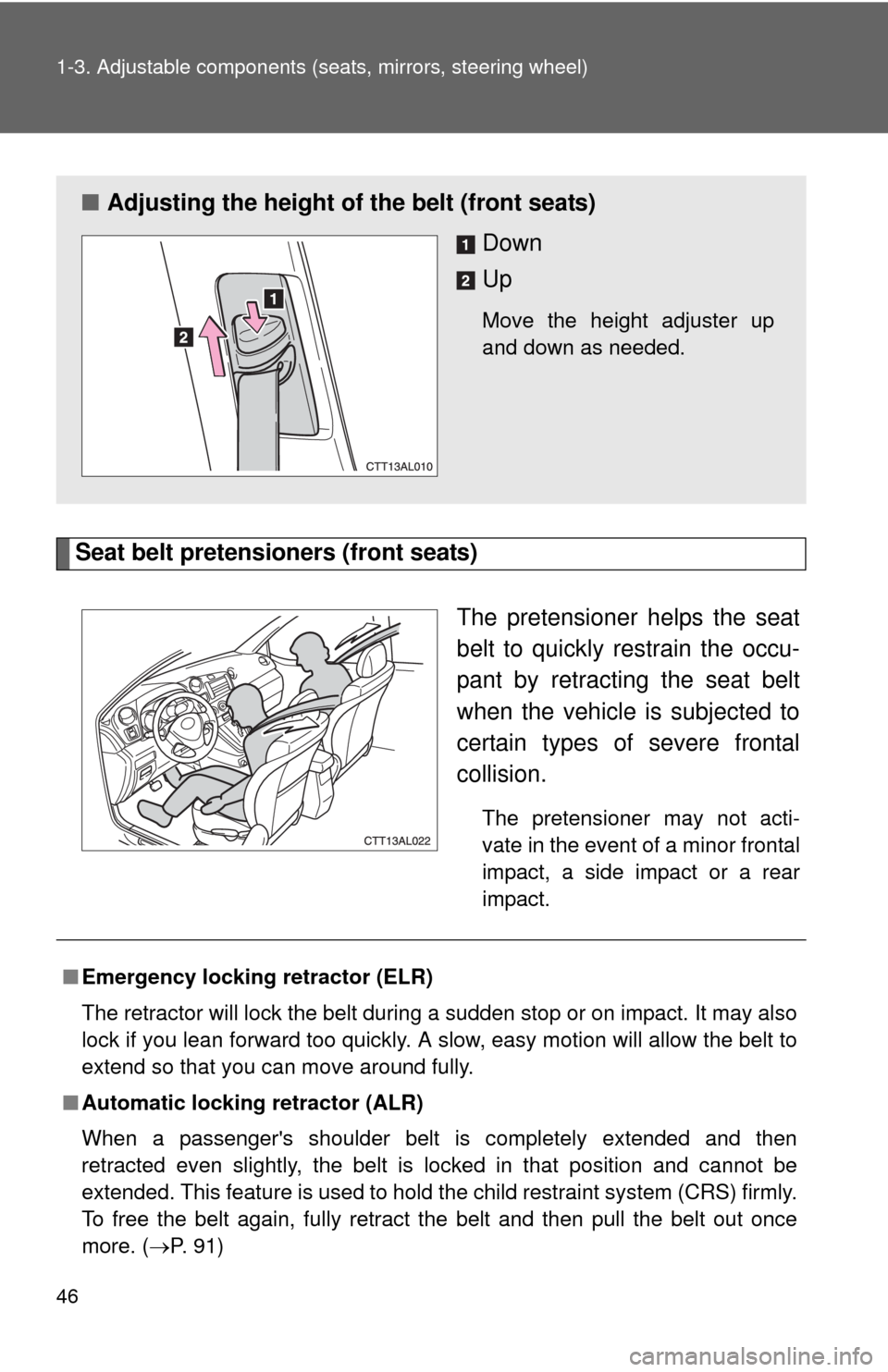
46 1-3. Adjustable components (seats, mirrors, steering wheel)
Seat belt pretensioners (front seats)
The pretensioner helps the seat
belt to quickly restrain the occu-
pant by retracting the seat belt
when the vehicle is subjected to
certain types of severe frontal
collision.
The pretensioner may not acti-
vate in the event of a minor frontal
impact, a side impact or a rear
impact.
■Adjusting the height of the belt (front seats)
Down
Up
Move the height adjuster up
and down as needed.
■Emergency locking retractor (ELR)
The retractor will lock the belt during a sudden stop or on impact. It may also
lock if you lean forward too quickly. A slow, easy motion will allow the belt to
extend so that you can move around fully.
■Automatic locking retractor (ALR)
When a passenger's shoulder belt is completely extended and then
retracted even slightly, the belt is locked in that position and cannot be
extended. This feature is used to hold the child restraint system (CRS) firmly.
To free the belt again, fully retract the belt and then pull the belt out once
more. (P. 91)
Page 47 of 448

47 1-3. Adjustable components (seats, mirrors, steering wheel)
1
Before driving
■Pregnant women
■People suffering illness
Obtain medical advice and wear the seat belt in the proper way.
■Child seat belt usage
The seat belts of your vehicle were principally designed for persons of adult
size.
●Use a child restraint system appropriate for the child, until the child
becomes large enough to properly wear the vehicle's seat belt. (P. 87)
●When the child becomes large enough to properly wear the vehicle's seat
belt, follow the instructions on P. 45 regarding seat belt usage.
■Replacing the belt after the pretensioner has been activated
If the vehicle is involved in multiple collisions, the pretensioner will activate
for the first collision, but will not activate for the second or subsequent colli-
sions.
■Seat belt extender
Obtain medical advice and wear the seat
belt in the proper way. (P. 45)
Women who are pregnant should position
the lap belt as low as possible over the
hips in the same manner as other occu-
pants. Extend the shoulder belt com-
pletely over the shoulder and position the
belt across the chest. Avoid belt contact
over the rounding of the abdominal area.
If the seat belt is not worn properly, not
only a pregnant woman, but also the fetus
could suffer death or serious injury as a
result of sudden braking or a collision.
If your seat belts cannot be fastened
securely because they are not long
enough, a personalized seat belt
extender is available from your Toyota
dealer free of charge.
Page 48 of 448
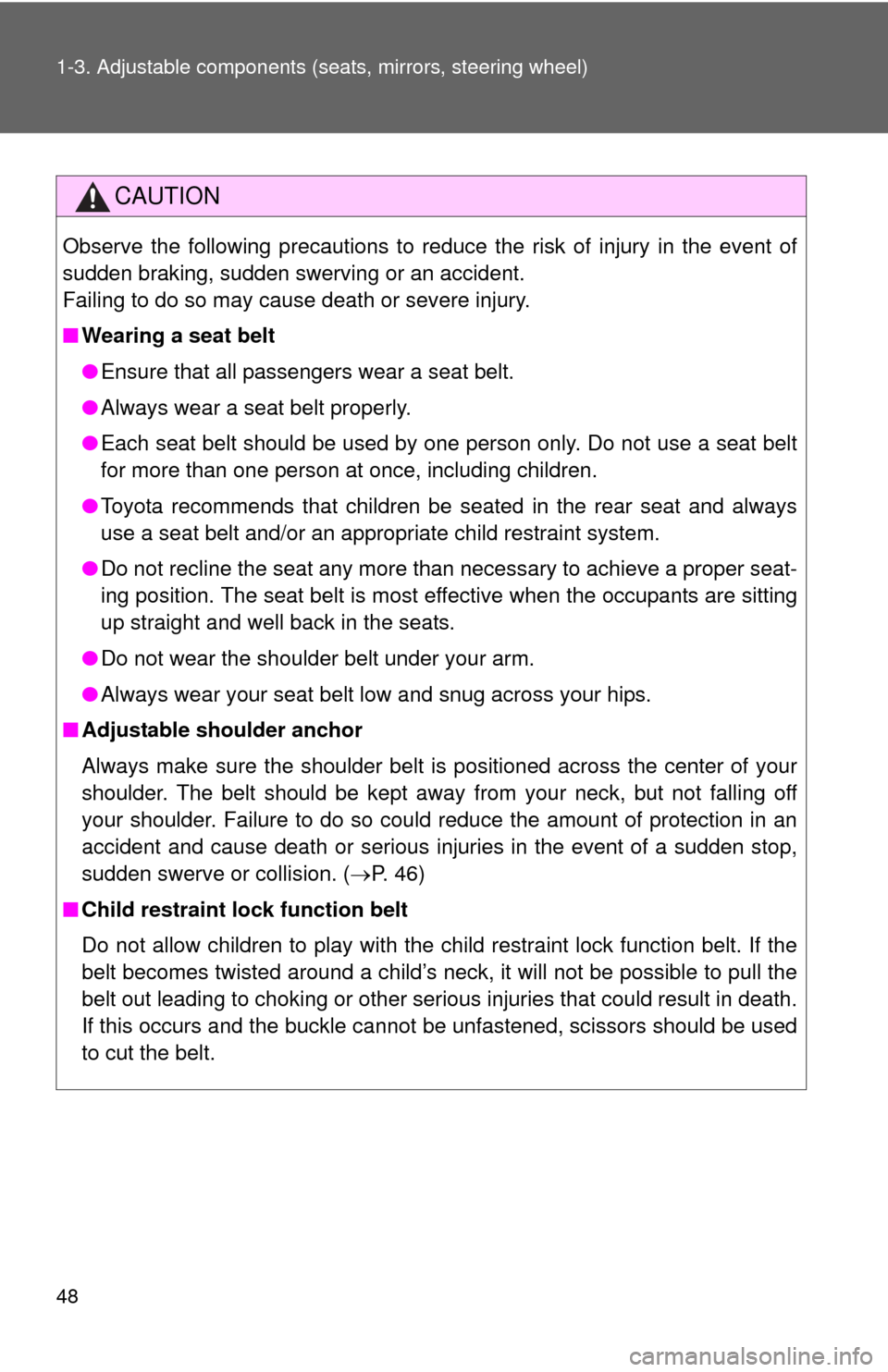
48 1-3. Adjustable components (seats, mirrors, steering wheel)
CAUTION
Observe the following precautions to reduce the risk of injury in the event of
sudden braking, sudden swerving or an accident.
Failing to do so may cause death or severe injury.
■Wearing a seat belt
●Ensure that all passengers wear a seat belt.
●Always wear a seat belt properly.
●Each seat belt should be used by one person only. Do not use a seat belt
for more than one person at once, including children.
●Toyota recommends that children be seated in the rear seat and always
use a seat belt and/or an appropriate child restraint system.
●Do not recline the seat any more than necessary to achieve a proper seat-
ing position. The seat belt is most effective when the occupants are sitting
up straight and well back in the seats.
●Do not wear the shoulder belt under your arm.
●Always wear your seat belt low and snug across your hips.
■Adjustable shoulder anchor
Always make sure the shoulder belt is positioned across the center of your
shoulder. The belt should be kept away from your neck, but not falling off
your shoulder. Failure to do so could reduce the amount of protection in an
accident and cause death or serious injuries in the event of a sudden stop,
sudden swerve or collision. (P. 46)
■Child restraint lock function belt
Do not allow children to play with the child restraint lock function belt. If the
belt becomes twisted around a child’s neck, it will not be possible to pull the
belt out leading to choking or other serious injuries that could result in death.
If this occurs and the buckle cannot be unfastened, scissors should be used
to cut the belt.
Page 49 of 448
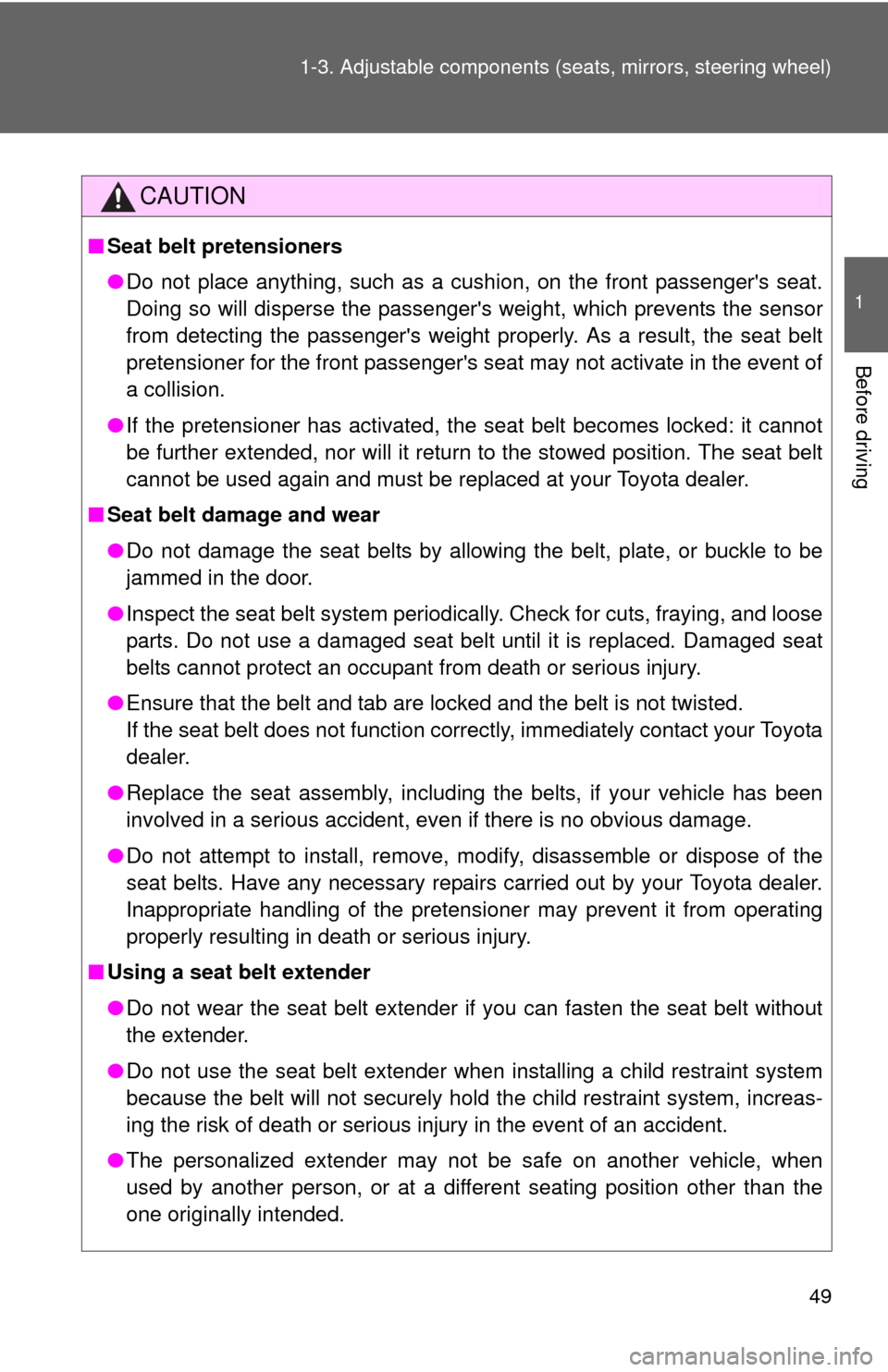
49 1-3. Adjustable components (seats, mirrors, steering wheel)
1
Before driving
CAUTION
■Seat belt pretensioners
●Do not place anything, such as a cushion, on the front passenger's seat.
Doing so will disperse the passenger's weight, which prevents the sensor
from detecting the passenger's weight properly. As a result, the seat belt
pretensioner for the front passenger's seat may not activate in the event of
a collision.
●If the pretensioner has activated, the seat belt becomes locked: it cannot
be further extended, nor will it return to the stowed position. The seat belt
cannot be used again and must be replaced at your Toyota dealer.
■Seat belt damage and wear
●Do not damage the seat belts by allowing the belt, plate, or buckle to be
jammed in the door.
●Inspect the seat belt system periodically. Check for cuts, fraying, and loose
parts. Do not use a damaged seat belt until it is replaced. Damaged seat
belts cannot protect an occupant from death or serious injury.
●Ensure that the belt and tab are locked and the belt is not twisted.
If the seat belt does not function correctly, immediately contact your Toyota
dealer.
●Replace the seat assembly, including the belts, if your vehicle has been
involved in a serious accident, even if there is no obvious damage.
●Do not attempt to install, remove, modify, disassemble or dispose of the
seat belts. Have any necessary repairs carried out by your Toyota dealer.
Inappropriate handling of the pretensioner may prevent it from operating
properly resulting in death or serious injury.
■Using a seat belt extender
●Do not wear the seat belt extender if you can fasten the seat belt without
the extender.
●Do not use the seat belt extender when installing a child restraint system
because the belt will not securely hold the child restraint system, increas-
ing the risk of death or serious injury in the event of an accident.
●The personalized extender may not be safe on another vehicle, when
used by another person, or at a different seating position other than the
one originally intended.
Page 78 of 448

78 1-7. Safety information
CAUTION
■SRS airbag precautions
●The SRS front passenger airbag also deploys with considerable force, and
can cause death or serious injury especially if the front passenger is very
close to the airbag. The front passenger seat should be as far from the air-
bag as possible with the seatback adjusted, so the front passenger sits
upright.
●Improperly seated and/or restrained infants and children can be killed or
seriously injured by a deploying airbag. An infant or child who is too small
to use a seat belt should be properly secured using a child restraint sys-
tem. Toyota strongly recommends that all infants and children be placed in
the rear seats of the vehicle and properly restrained. The rear seats are
the safest for infants and children. (P. 87)
●If the seat belt extender has been con-
nected to the driver's seat belt buckle
but the seat belt extender has not also
been fastened to the latch plate of the
driver's seat belt, the SRS driver's air-
bag system will judge that the driver is
wearing the seat belt even though the
seat belt has not been connected. In
this case, the driver's airbag may not
activate correctly in a collision, resulting
in death or serious injury in the event of
collision. Be sure to wear the seat belt
with the seat belt extender.
●Do not sit on the edge of the seat or
lean against the dashboard.
Page 83 of 448

83 1-7. Safety information
1
Before driving
Conditions and operation of the front passenger occupant classification system
■Adult*1
■Child*3 or child restraint system*4
Indicator/
warning light
“AIR BAG ON” and “AIR BAG OFF” indicator
lights“AIR BAG
ON”
SRS warning light Off
Front passenger’s seat belt reminder light Flashing
*2
DevicesFront passenger airbag
Activated Side airbag on the front
passenger seats
Curtain shield airbag in the front
passenger side
Front passenger’s seat belt pretensioner
Indicator/
warning light
“AIR BAG ON” and “AIR BAG OFF” indicator
lights“AIR BAG
OFF”*5
SRS warning light Off
Front passenger’s seat belt reminder light Flashing
*2
DevicesFront passenger airbag
Deactivated
Side airbag on the front
passenger seats
Curtain shield airbag in the front
passenger side
Activated
Front passenger’s seat belt pretensioner
Page 84 of 448

84 1-7. Safety information
■Unoccupied
■There is a malfunction in the system
*1: The system judges a person of adult size as an adult. When a
smaller adult sits in the front passenger seat, the system may rec-
ognize him/her as a child depending on his/her physique and pos-
ture.
*2: In the event the front passenger does not wear a seat belt.
*3: When a larger child who has outgrown a child restraint system
sits in the front passenger seat, the system may recognize him/
her as an adult depending on his/her physique or posture.
Indicator/
warning light
“AIR BAG ON” and “AIR BAG OFF” indicator
lightsNot illuminated
SRS warning light
Off
Front passenger’s seat belt reminder light
DevicesFront passenger airbag
Deactivated
Side airbag on the front
passenger seats
Curtain shield airbag in the front
passenger sideActivated
Front passenger’s seat belt pretensioner Deactivated
Indicator/
warning light
“AIR BAG ON” and “AIR BAG OFF” indicator
lights“AIR BAG
OFF”
SRS warning light On
Front passenger’s seat belt reminder light Off
DevicesFront passenger airbag
Deactivated
Side airbag on the front
passenger seats
Curtain shield airbag in the front
passenger side
Activated
Front passenger’s seat belt pretensioner
Page 85 of 448
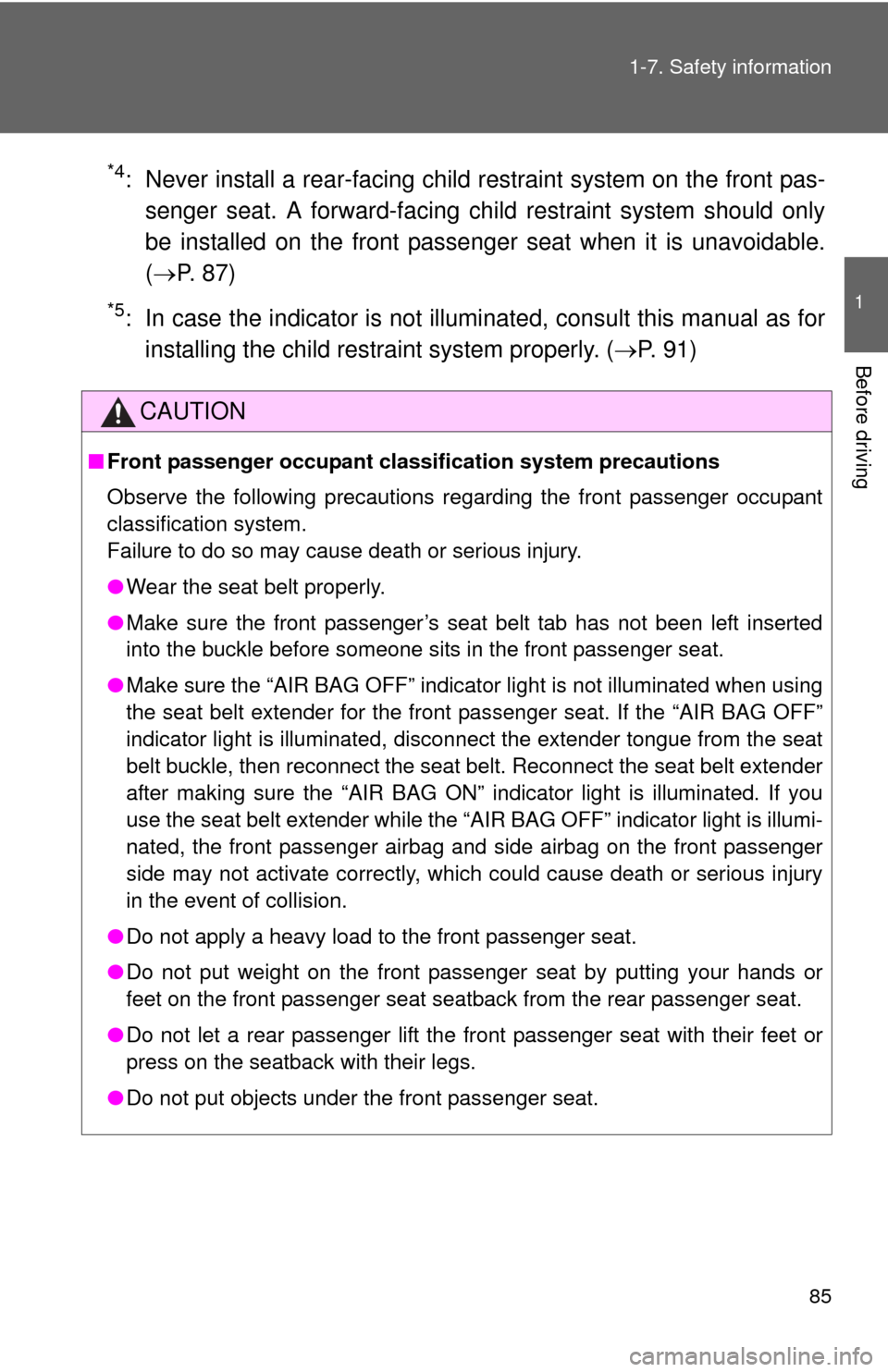
85 1-7. Safety information
1
Before driving
*4: Never install a rear-facing child restraint system on the front pas-
senger seat. A forward-facing child restraint system should only
be installed on the front passenger seat when it is unavoidable.
(P. 87)
*5: In case the indicator is not illuminated, consult this manual as for
installing the child restraint system properly. (P. 91)
CAUTION
■Front passenger occupant classification system precautions
Observe the following precautions regarding the front passenger occupant
classification system.
Failure to do so may cause death or serious injury.
●Wear the seat belt properly.
●Make sure the front passenger’s seat belt tab has not been left inserted
into the buckle before someone sits in the front passenger seat.
●Make sure the “AIR BAG OFF” indicator light is not illuminated when using
the seat belt extender for the front passenger seat. If the “AIR BAG OFF”
indicator light is illuminated, disconnect the extender tongue from the seat
belt buckle, then reconnect the seat belt. Reconnect the seat belt extender
after making sure the “AIR BAG ON” indicator light is illuminated. If you
use the seat belt extender while the “AIR BAG OFF” indicator light is illumi-
nated, the front passenger airbag and side airbag on the front passenger
side may not activate correctly, which could cause death or serious injury
in the event of collision.
●Do not apply a heavy load to the front passenger seat.
●Do not put weight on the front passenger seat by putting your hands or
feet on the front passenger seat seatback from the rear passenger seat.
●Do not let a rear passenger lift the front passenger seat with their feet or
press on the seatback with their legs.
●Do not put objects under the front passenger seat.